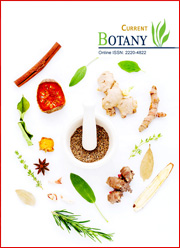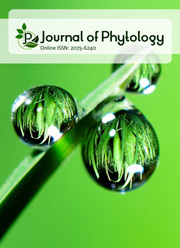Studies on crossability among different varieties of Ananas comosus (L.) Merr. (Bromeliaceae)
DOI:
https://doi.org/10.25081/cb.2025.v16.9498Keywords:
Ananas comosus, Self-sterility, Crossability, Seed setAbstract
Pineapple (Ananas comosus (L). Merr.) is a self incompatible plant. But hybridization is possible between different cultivars and varieties of pineapple. In the present study crossing experiments were carried out among different varieties of pineapple to assess the crossability among these varieties. In vitro pollen germination studies showed maximum pollen germination in A. comosus cv. MD2 in Brewbaker’s medium with 25% sucrose (85.57%). In self pollinated pistil, pollen grains were germinated on the stigma and penetrated into the style, but never grew deep into the style. After cross pollination, the pollen grains germinated on the stigmatic surface, penetrated and grow deep into the style. No seed set was observed in commercial cultivars after self pollination. But, a few seeds were produced in A. comosus var. bracteatus. In cross pollination experiments, seed set was observed in all crosses. The percentage of crossability and the number of seeds per fruitlet varied among different crosses. The cross between A. comosus cv. Mauritius female and A. comosus cv. Kew male showed maximum percentage of crossability and cross between A. comosus cv. MD2 female and A. comosus cv. Mauritius male produced the maximum number of seeds per fruitlet. The percentage of seed germination showed significant variation among the seeds produced from different crosses. The seedlings transferred to pots containing potting mixture showed vigorous growth.
Downloads
References
Brewbaker, J. L., & Gorrez, D. D. (1967). Genetics of Self-Incompatibility in the Monocot Genera, Ananas (Pineapple) and Gasteria. American Journal of Botany, 54(5), 611-616. https://doi.org/10.2307/2440666
Brewbaker, J. L., & Kwack, B. H. (1963). The essential role of calcium ion in pollen germination and pollen tube growth. American Journal of Botany, 50(9), 859-865. https://doi.org/10.1002/j.1537-2197.1963.tb06564.x
Cabot, C. (1987). Practice of pineapple breeding. Acta Horticulturae, 196, 25-36. https://doi.org/10.17660/ActaHortic.1987.196.2
Cabral, J. R. S., de Matos, A. P., & da Cunha, G. A. P. (1993). Selection of pineapple Cultivars resistant to fusariose. Acta Horticulturae, 334, 53-58. https://doi.org/10.17660/ActaHortic.1993.334.5
Chakraborty, S., Dutta, S., & Das, M. (2023). Genetics behind sexual incompatibility in plants: How much we know and what more to uncover?. Journal of Plant Growth Regulation, 42, 7164-7188. https://doi.org/10.1007/s00344-023-11005-z
Chan, Y. K. (1997). Performance and stability of pineapple hybrids in G×E trials in Malaysia. Acta Horticulturae, 425, 201-211. https://doi.org/10.17660/ActaHortic.1997.425.22
Collins, J. L. (1960). The Pineapple: Botany, Cultivation and Utilization. New York, US: Inter science Publishers.
Coppens d’ Eeckenbrugge, G., Duval, M. F., & Van Miegroet, F. (1993). Fertility and self- incompatibility in the genus Ananas. Acta Horticulturae, 334, 45-51. https://doi.org/10.17660/ActaHortic.1993.334.4
Duval, M. F., & Coppens d’Eeckenbrugge, G. (1993). Genetic variability in the genus Ananas comosus. Acta Horticulturae, 334, 27-32. https://doi.org/10.17660/ActaHortic.1993.334.2
Fitchet, M. (1989). Observations on pineapple improvement in Taiwan, Republic of China. Subtropica, 10, 10-12.
Janssen, A. W. B., & Hermsen, J. G. T. H. (1976). Estimating pollen fertility in Solanum species and haploids. Euphytica, 25, 577-586. https://doi.org/10.1007/BF00041595
Johri, B. M., & Vasil, I. K. (1961). Physiology of pollen. The Botanical Review, 27, 325-381. https://doi.org/10.1007/BF02860810
Majumder, S. K., Kerns, K. R., Brewbaker, J. L., & Johannessen, G. A. (1964). Assessing self-incompatibility by a pollen fluorescence technique. Proceedings of the American Society for Horticultural Science, 84, 217-223.
Martin, F. W. (1959). Staining and observing pollen tubes in the styles by means of fluorescence. Stain Technology, 34, 125-128.
Nisha, A. P. (2019). Analysis of diversity and crossability among the cultivated varieties of Ananas comosus L. (Merr.) (Bromeliaceae). Doctoral Dissertation, University of Kerala.
Ramírez, O. D., Gandía, H., & Velez-Fortuño, H. (1972). A new pineapple selection. Fruit Varieties and Horticulture Digest, 26, 13-15.
Rane, P., Thakre, M., Verma, M. K., Prakash, J., Kumar, C., Srivastava, V., Shashank, P. R., & Murukan, N. (2023). Standardization of pollen collection method and in vitro pollen germination media in grapes. The Pharma Innovation Journal, 12(12), 3159-3161.
Shivanna, K. R., & Johri, B. M. (1989). The angiosperm pollen: Structure and function. New Delhi, India: Wiley Eastern.
Steer, M. W., & Steer, J. M. (1989). Pollen tube tip growth. New Phytolologist, 111(3), 323-358. https://doi.org/10.1111/j.1469-8137.1989.tb00697.x
Wee, Y. C. (1974). The Mesmerah pineapple: a new cultivar for the Malaysian pineapple industry. World Crops, 26(2), 67-76.
Wee, Y. C., & Rao, A. N. (1979). Ananas pollen germination. Grana, 18(1), 33-39. https://doi.org/10.1080/00173137909428868
Published
How to Cite
Issue
Section
Copyright (c) 2025 A. P. Nisha, Vrindha Vijayan, P. M. Radhamany

This work is licensed under a Creative Commons Attribution-NonCommercial 3.0 Unported License.



 .
.